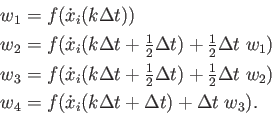
Next: Time-invariant dynamical systems Up: 8.3.2 Numerical simulation Previous: Sampling rate Contents Index
The approximation used in (8.21) is known as Euler integration. It is the simplest approximation, but does not perform well enough in many practical settings. One of the most common improvements is the fourth-order Runge-Kutta integration method, which expresses the new state as
![$\displaystyle x_i[k+1] \approx x_i[k] + \frac{\Delta t}{6} (w_1 + 2 w_2 + 2 w_3 + w_4) ,$](img767.gif) |
(8.23) |
 |
(8.24) |